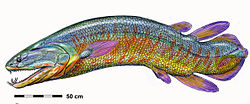| Onychodontiformes Temporal range: Possible Lochkovian record [1] | |
|---|---|
 | |
| Reconstruction of Onychodus | |
| Scientific classification | |
| Kingdom: | Animalia |
| Phylum: | Chordata |
| Clade: | Sarcopterygii |
| Order: | † Onychodontiformes Andrews, 1973 |
| Genera | |
| |
Onychodontiformes (also known as Onychodontida and Struniiformes) is an order of prehistoric sarcopterygian fish that lived during the Devonian period. The onychodontiforms are generally regarded as early-diverging members of the coelacanth lineage. [2] [1]





